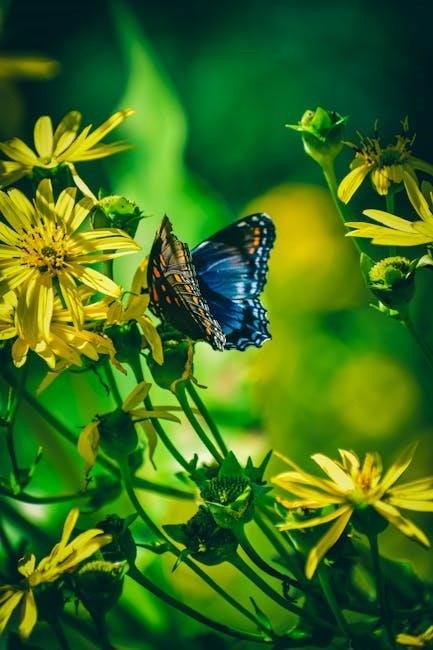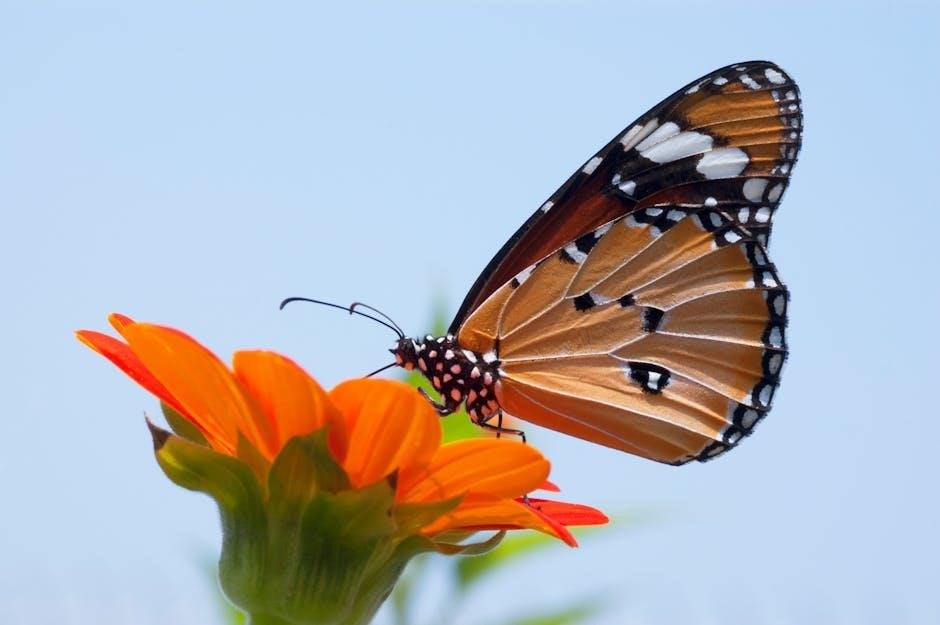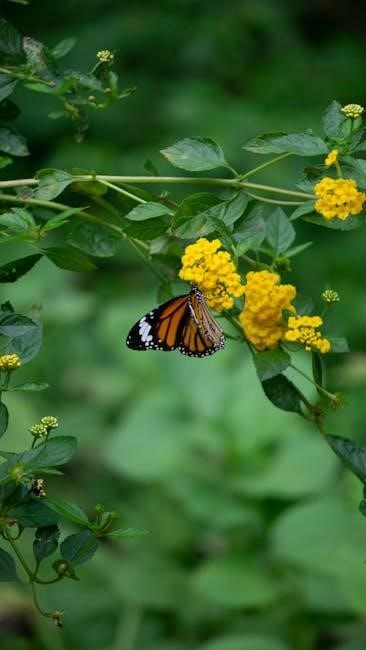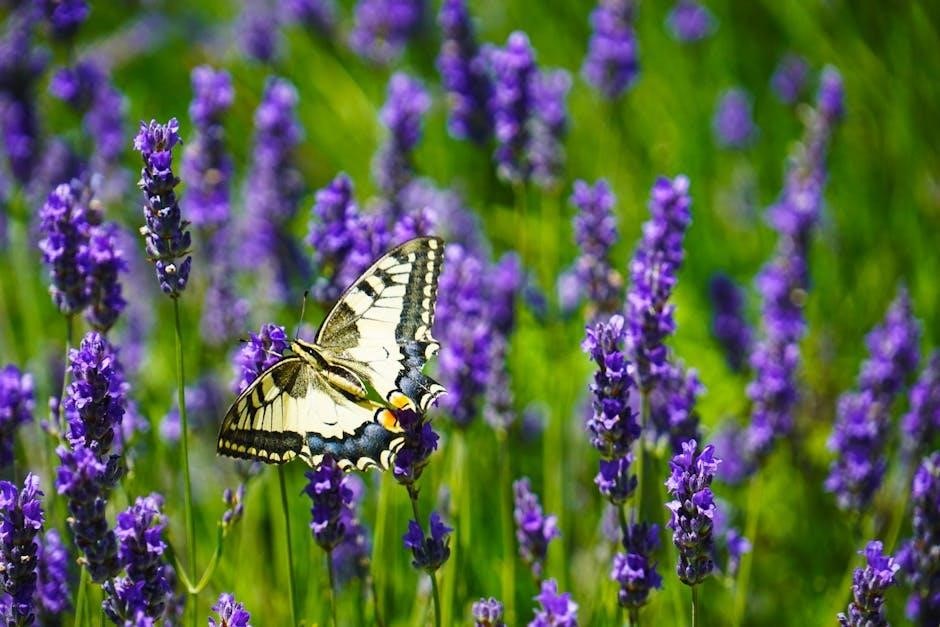Butterfly gardening is a delightful way to attract these beautiful creatures, creating a vibrant ecosystem that supports their life cycle and adds beauty to your outdoor space.
1.1 Understanding the Importance of Butterfly Gardens
Butterfly gardens play a vital role in supporting biodiversity by providing habitats for these delicate creatures. They offer essential resources like nectar for adults and host plants for caterpillars, ensuring survival across life stages. These gardens also act as pollinator hotspots, benefiting other wildlife and plants. By creating such spaces, you contribute to local ecosystems, helping butterfly populations thrive amid environmental challenges. Additionally, they inspire awareness and education about conservation, fostering a deeper connection with nature and its beauty.
1.2 Benefits of Creating a Butterfly-Friendly Environment
Creating a butterfly-friendly environment enhances local biodiversity, supports pollinators, and fosters ecological balance. These gardens attract diverse species, adding vibrant beauty to outdoor spaces. They also provide educational opportunities, teaching about butterfly life cycles and conservation. By offering nectar and host plants, you support both adult butterflies and their caterpillars, ensuring their survival. This effort contributes to environmental sustainability and offers a serene, nature-connected space for relaxation and enjoyment, benefiting both wildlife and gardeners alike.

Choosing the Right Location for Your Butterfly Garden
Select a sunny, sheltered spot with good drainage to create an ideal butterfly garden. Ensure it receives at least six hours of direct sunlight daily for optimal conditions.
2.1 Selecting a Sunny and Sheltered Spot
Butterflies thrive in warmth, so choose a location that receives at least six hours of direct sunlight daily. A sheltered spot protects them from harsh winds, creating a serene environment. Ensure the area is away from strong gusts and shaded areas to maintain optimal conditions for butterfly activity and plant growth. This setup ensures your garden becomes a haven for these delicate creatures, fostering their natural behaviors and beauty.
2.2 Ensuring Proper Drainage and Soil Conditions
Proper drainage and soil conditions are vital for a thriving butterfly garden. Choose a site with well-draining soil to prevent waterlogged roots, which can harm plants. Test drainage by observing how water absorbs after rainfall. Ideal soil is slightly sandy or loamy, as butterflies prefer these textures. Incorporate compost to enhance fertility and drainage. Ensure the soil pH aligns with the needs of your chosen plants, as most butterfly-friendly species thrive in slightly acidic to neutral soil (pH 6.0–7.0). This foundation supports healthy plant growth, attracting more butterflies to your garden.

Selecting the Right Plants for Your Butterfly Garden
Selecting the right plants is crucial for attracting butterflies, providing nectar for adults and host plants for caterpillars to ensure a thriving ecosystem with diverse species.
3.1 Nectar Plants for Adult Butterflies
Nectar plants are essential for adult butterflies, providing energy-rich food to fuel their flight and reproduction. Flowers like milkweed, butterfly bush, and aster are ideal, as they produce abundant nectar. These plants attract a variety of species, ensuring a vibrant and diverse butterfly population. Planting them in groups makes it easier for butterflies to locate the food sources. Incorporating a mix of annuals and perennials ensures a constant nectar supply throughout the growing season, supporting these beautiful creatures year-round.
3.2 Host Plants for Butterfly Caterpillars
Host plants are vital for butterfly caterpillars, providing the specific foliage they need to survive and grow. Milkweed, for instance, is crucial for monarch caterpillars, while passionflower supports zebra longwing larvae. Dill and parsley attract swallowtail caterpillars, offering them the necessary nutrients. Planting these species-specific host plants ensures caterpillars have the food they need to thrive. This step is essential for supporting the full life cycle of butterflies, transforming your garden into a nurturing habitat for these delicate creatures to grow and flourish.
3.3 Planting a Variety of Flowers for Different Species
Planting a variety of flowers attracts a diverse range of butterfly species, ensuring a dynamic and thriving ecosystem. Incorporate nectar-rich blooms like asters, zinnias, and marigolds, which cater to adult butterflies. Mix in host plants such as milkweed and dill to support caterpillars. By selecting flowers of different heights and bloom times, your garden becomes a year-round haven, offering constant resources for various butterfly species and fostering biodiversity in your outdoor space.
Designing Your Butterfly Garden Layout
Arrange plants by height and growth habits, ensuring a balanced and visually appealing design. Incorporate native plants and cluster flowers to create a welcoming habitat for butterflies.
4.1 Arranging Plants by Height and Growth Habits
Organize plants in your butterfly garden by height and growth habits to create a balanced layout. Taller plants like shrubs or perennials should be placed at the back or center, while shorter, spreading plants like ground covers or low-growing flowers can be positioned around the edges. This arrangement ensures that all plants receive adequate sunlight and airflow, promoting healthy growth and making it easier for butterflies to access nectar sources. Proper spacing also prevents overcrowding, reducing competition for resources and minimizing the risk of disease spread. Additionally, grouping plants with similar growth habits encourages a natural, harmonious environment that attracts a variety of butterfly species. By thoughtfully arranging your plants, you can create a visually appealing and functional butterfly garden that supports biodiversity and offers a welcoming space for these beautiful insects.
4.2 Incorporating Native Plants for Local Butterfly Species
Incorporating native plants into your butterfly garden is essential for attracting local butterfly species. Native plants have evolved alongside local butterflies, providing the specific nectar and host plants they need. Milkweed, for instance, is crucial for monarch butterflies, while aster flowers support pearl crescent butterflies. By using native species, you create a familiar and welcoming environment tailored to the needs of local butterflies, ensuring they thrive and successfully reproduce. This approach also supports biodiversity and requires less maintenance, as native plants are adapted to the local climate and soil conditions.

Providing Essential Resources for Butterflies
Butterflies need water for drinking and puddling, as well as shelter from wind and predators. Incorporating these elements ensures a welcoming habitat for these delicate creatures.
5.1 Installing a Water Source for Drinking and Puddling
Butterflies need water for drinking and puddling, a behavior where they extract minerals from mud. Use a shallow dish or birdbath with fresh water and rocks for perching. Change water regularly to prevent stagnation and maintain cleanliness. Avoid using chemicals, as they can harm butterflies. Place the water source in a sunny, sheltered spot to create an ideal environment for these delicate creatures to thrive and replenish essential nutrients.
5.2 Creating Shelter from Wind and Predators
Butterflies need shelter from strong winds and predators to feel secure. Incorporate native shrubs, grasses, or evergreen plants to provide natural hiding spots. Consider adding a fence or trellis to block harsh winds. Planting dense vegetation in sheltered areas creates a safe habitat for butterflies to rest and roost. Ensure these shelters are placed strategically near food and water sources to encourage butterflies to stay and thrive in your garden, protected from environmental stressors.

Maintaining Your Butterfly Garden
Regular upkeep ensures your butterfly garden remains vibrant and inviting. Refresh water sources, keep soil moist, and manage plant growth to support a thriving ecosystem for butterflies and pollinators.
6.1 Watering and Mulching to Retain Moisture
Proper watering and mulching are essential for maintaining a thriving butterfly garden. Water plants deeply but avoid waterlogging, as this can harm roots and attract pests. Mulching helps retain soil moisture, suppress weeds, and regulate temperature. Use organic mulch like wood chips or bark, keeping it thin to prevent suffocating plants. Regularly refresh water sources, such as shallow dishes or ponds, to ensure butterflies have consistent access to drinking water. Consistent moisture management supports healthy plant growth and attracts pollinators.
6.2 Deadheading Flowers to Encourage More Blooms
Deadheading, or removing spent flowers, is a simple yet effective practice for maintaining a vibrant butterfly garden. By eliminating wilted blooms, plants redirect energy into producing new flowers, extending the blooming period and attracting more butterflies. Use scissors or pinch off faded flowers, taking care not to damage stems or adjacent buds. Regular deadheading, especially for nectar-rich plants like milkweed and zinnias, ensures a constant source of food for adult butterflies, enhancing their visitation and overall garden health.
6.4 Pruning and Managing Plant Growth
Pruning and managing plant growth are essential for maintaining a thriving butterfly garden. Regularly trim overgrown shrubs and perennials to promote healthy growth and prevent overcrowding. Prune leggy stems to encourage branching, which increases flower production and attracts more butterflies. Remove dead or diseased plant material to prevent the spread of infection. Prune during dormancy or after blooms fade to avoid disrupting pollinators. This practice ensures plants remain robust, providing continuous food sources for both adult butterflies and their caterpillars, fostering a balanced ecosystem.
Avoiding Pesticides and Harmful Chemicals
Avoiding pesticides is crucial for butterfly conservation, as these chemicals can decimate butterfly populations and harm other beneficial insects. Use natural methods to control pests instead.
7.1 The Impact of Pesticides on Butterfly Populations
Pesticides pose a significant threat to butterfly populations by contaminating their food sources and habitats. These chemicals can kill butterflies directly or weaken their immune systems, making them vulnerable to diseases and predators. Additionally, pesticides disrupt the balance of ecosystems, reducing the availability of host plants essential for caterpillars. Even low levels of exposure can impair reproduction and navigation abilities in butterflies. This highlights the urgent need to adopt organic gardening practices to protect these vital pollinators.
7.2 Alternative Methods for Managing Pests
Adopting organic pest control methods is crucial for maintaining a butterfly-friendly garden. Use natural predators like ladybugs and lacewings to manage pest populations. Introduce beneficial insects that target common garden pests, reducing the need for harmful chemicals. Companion planting is another effective strategy; certain plants repel pests naturally. For example, marigolds deter nematodes, while basil repels aphids. Additionally, crop rotation and hand-picking pests can prevent infestations without harming butterflies. These methods ensure a balanced ecosystem and protect pollinators.
Monitoring and Enjoying Your Butterfly Garden
Observing the diverse butterfly species and documenting your garden’s progress can be incredibly rewarding. This vibrant space not only attracts wildlife but also enhances your outdoor enjoyment.
8.1 Observing and Identifying Butterfly Species
Observing butterflies in your garden is a delightful experience. Use field guides or apps to identify species based on color, wing patterns, and flight behaviors. Noting the time of year and plants they visit can help pinpoint species. Documenting your sightings in a journal or photos adds fun and helps track progress. This practice also aids in learning their life cycles and preferences, enhancing your ability to create a welcoming habitat for these beautiful creatures.
8.2 Documenting the Progress of Your Garden
Documenting your garden’s progress is a rewarding way to track its evolution and success. Keep a journal to record plant growth, blooming cycles, and visiting butterfly species. Take photos regularly to capture changes and milestones. Note weather patterns, pest occurrences, and adjustments made to the garden. This documentation helps identify patterns, refine strategies, and plan future improvements. It also serves as a valuable resource for sharing insights with fellow gardeners or conservation efforts, fostering a deeper connection to your butterfly sanctuary.

Leave a Reply